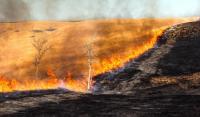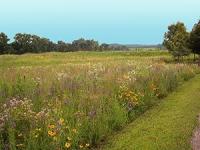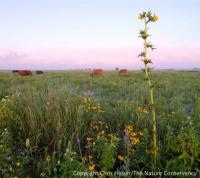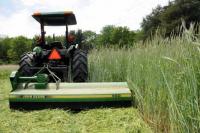The purpose of grassland management is to provide a quality stand of grass that will offer the best possible wildlife habitat. There are a variety of effective techniques that can be used based on the landscape and availability of equipment.
If participating in a program, follow specific programmatic requirements. Please consult with your local USDA Service Center for a more in-depth look at your site’s specific management strategy.
Prescribed Burning
Prescribed burning can suppress woody vegetation, release nutrients bound in plant litter, stimulate new growth, and improve flowering plant growth. Burn plans are needed to define the details of how the burn will be conducted, who will be involved and for contingency planning. Below are tips for incorporating prescribed burning as a management tool.
- Obtain any necessary permits when planning for a prescribed burn
- Mow burn breaks the fall prior to burning
- Burn after late April to set back aggressive/cool-season grasses OR burn in the fall (October - November) to stimulate native forbs
- Do not burn during peak nesting season (May 15th - August 1st)
- Burn every 3-5 years for a healthy stand
- Burning rotations are encouraged for wildlife habitat benefits
Haying
Haying can be used in areas where prescribed burns are dangerous or otherwise tough to conduct and can be effective for woody vegetation control. Below are tips for incorporating haying as a management tool.
- Where practical, wildlife friendly haying techniques should be utilized. Begin in the center of the field and work outward or begin on one end of the field and work back and forth.
- Highest protein for forage is during mid-summer. Mid-summer haying also gives a chance for re-growth before fall.
- Hay post-nesting season (after August 1st)
- Hay every 3-5 years for a healthy stand
Grazing
Grazing can be an economically friendly option for landowners with cattle and can be used as a complimentary management practice with prescribed burning. Below are tips for incorporating grazing as a management tool.
- Consult with a grazing specialist in advance to discuss stocking rates, timing, and duration
- Graze during late spring/early summer to suppress cool-season grasses (smooth brome, Kentucky bluegrass) growth
- Graze in mid-summer to suppress woody vegetation growth and enhance warm-season grass tillering
- Use a rotational grazing system
- Graze on a 4-5 year rotation
Mowing
Mowing can be used for grassland management during establishment to suppress weed competitions. Below are tips for incorporating mowing as a management tool.
- Where practical, wildlife friendly mowing techniques should be utilized. Begin in the center of the field and work outward or begin on one end of the field and work back and forth.
- Use a rotary/flail mower or stalk chopper
- Mow cool-season grasses no shorter than 6 inches. Native warm-season grasses should be mowed no shorter than 10 inches.
- Mow post-nesting season (after August 1st)
- Mow every 3-5 years for a healthy stand
- Mowing rotation is encouraged for wildlife benefits





